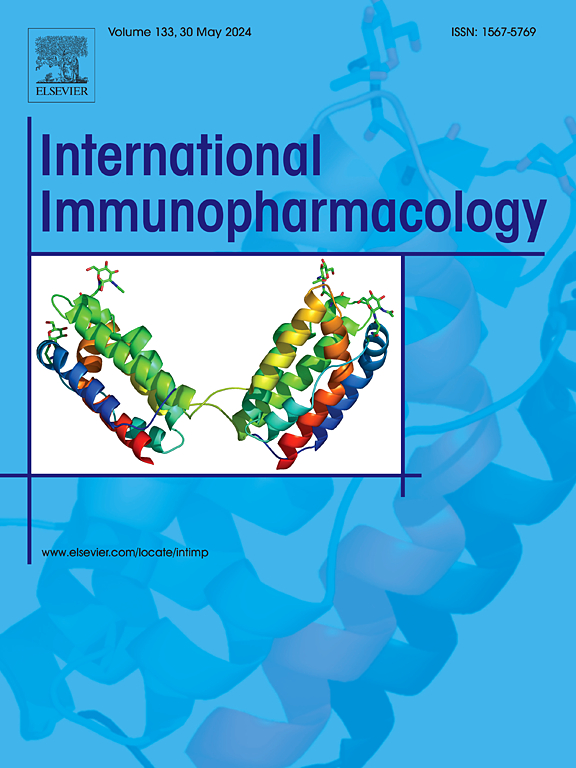Maackiain induces apoptosis and autophagy via ROS-mediated endoplasmic reticulum stress in endometrial cancer
IF 4.8
2区 医学
Q2 IMMUNOLOGY
引用次数: 0
Abstract
Endometrial cancer (EC) is a common gynecological cancer, characterized by increasing incidence and mortality rates. Maackiain (MA), a natural flavonoid compound, has multiple biological activities, but little is known about how it affects EC cells. In the present study, CCK-8, EdU, colony formation, and flow cytometry assays were used to evaluate the effects of MA on EC cell proliferation, apoptosis, and reactive oxygen species (ROS) levels. The effect of MA on autophagy in EC cells were examined through the observation of cell morphology and ultrastructure, and cells were transfected with AdPlus-mCherry-GFP-LC3B for further analysis. Transcriptomic and western blot analyses revealed the underlying mechanism. To evaluate the anti-EC effect of MA in vivo, a xenograft model was established. The results demonstrated that MA inhibited KLE and Ishikawa cell growth in a dose-dependent manner. Furthermore, MA significantly suppressed EC xenograft tumor growth in vivo while exhibiting low toxicity. In addition, EC cells treated with MA exhibited pro-apoptotic and pro-autophagic responses, with the latter exhibiting cytoprotective properties. MA also induced the accumulation of ROS, which promoted endoplasmic reticulum (ER) stress. Notably, the use of the N-acetyl-L-cysteine (NAC) ROS scavenger and the 4-phenylbutyric acid (4-PBA) ER stress inhibitor effectively mitigated the autophagy and apoptosis induced by MA. These results collectively implied that MA triggers autophagy and apoptosis in EC cells through ROS-mediated ER stress, highlighting its potential as a therapeutic agent against EC.

Maackiain通过ros介导的内质网应激诱导子宫内膜癌细胞凋亡和自噬。
子宫内膜癌(EC)是一种常见的妇科癌症,其特点是发病率和死亡率都在上升。Maackiain (MA)是一种天然的类黄酮化合物,具有多种生物活性,但对其如何影响EC细胞知之甚少。本研究通过CCK-8、EdU、集落形成和流式细胞术检测来评估MA对EC细胞增殖、凋亡和活性氧(ROS)水平的影响。通过观察细胞形态和超微结构,检测MA对EC细胞自噬的影响,并用AdPlus-mCherry-GFP-LC3B转染细胞进行进一步分析。转录组学和western blot分析揭示了潜在的机制。为了评估MA在体内的抗ec作用,我们建立了异种移植模型。结果表明,MA抑制KLE和石川细胞生长呈剂量依赖性。此外,MA在体内显著抑制EC异种移植瘤的生长,同时表现出低毒性。此外,MA处理的EC细胞表现出促凋亡和促自噬反应,后者具有细胞保护作用。MA还诱导活性氧积累,促进内质网(ER)应激。值得注意的是,使用n -乙酰- l-半胱氨酸(NAC) ROS清除剂和4-苯基丁酸(4-PBA)内质网应激抑制剂可以有效减轻MA诱导的自噬和凋亡。这些结果共同表明,MA通过ros介导的内质网应激触发EC细胞的自噬和凋亡,突出了其作为EC治疗剂的潜力。
本文章由计算机程序翻译,如有差异,请以英文原文为准。
求助全文
约1分钟内获得全文
求助全文
来源期刊
CiteScore
8.40
自引率
3.60%
发文量
935
审稿时长
53 days
期刊介绍:
International Immunopharmacology is the primary vehicle for the publication of original research papers pertinent to the overlapping areas of immunology, pharmacology, cytokine biology, immunotherapy, immunopathology and immunotoxicology. Review articles that encompass these subjects are also welcome.
The subject material appropriate for submission includes:
• Clinical studies employing immunotherapy of any type including the use of: bacterial and chemical agents; thymic hormones, interferon, lymphokines, etc., in transplantation and diseases such as cancer, immunodeficiency, chronic infection and allergic, inflammatory or autoimmune disorders.
• Studies on the mechanisms of action of these agents for specific parameters of immune competence as well as the overall clinical state.
• Pre-clinical animal studies and in vitro studies on mechanisms of action with immunopotentiators, immunomodulators, immunoadjuvants and other pharmacological agents active on cells participating in immune or allergic responses.
• Pharmacological compounds, microbial products and toxicological agents that affect the lymphoid system, and their mechanisms of action.
• Agents that activate genes or modify transcription and translation within the immune response.
• Substances activated, generated, or released through immunologic or related pathways that are pharmacologically active.
• Production, function and regulation of cytokines and their receptors.
• Classical pharmacological studies on the effects of chemokines and bioactive factors released during immunological reactions.

 求助内容:
求助内容: 应助结果提醒方式:
应助结果提醒方式:


